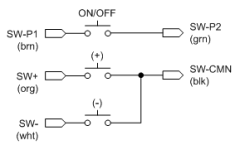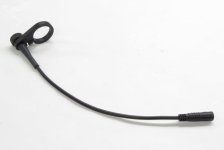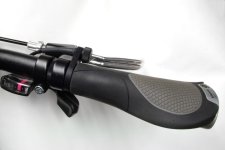I concur with mrbill's observations about locating the pot close at hand so adjustments are quick and easy. My pot is actually inside the bar with the knob on the bar end.
As far as the 'virtual torque' rpm assist is concerned, this runs in TorqPAS mode and is just a sleaze that uses a constant torque and the true rider cadence instead of both 'real' rider torque and rpm. So, it behaves somewhere in between the simple AutoPAS and true torque-based TorqPAS. If properly set up it can somewhat reduce the amount of pot adjustments necessary since it's a bit 'smart', but it's certainly miles from the automatic assist range of true torque sensing. This took me a while to get set up so that it didn't over-assist with too much gain with increasing rpm. I have it set up now so it pretty much carries the bike on the flat at the same effort at different speeds - just adjusted by cadence - but the speed range is not huge. I look at it entirely as a means to reduce the amount of pot adjustment instead of a universal solution. It's one of those things you need to mess with and even then you may decide that it simply doesn't fit your terrain and riding style.
In any case, any feedback or experiences comparing the approaches would be interesting.
As far as the 'virtual torque' rpm assist is concerned, this runs in TorqPAS mode and is just a sleaze that uses a constant torque and the true rider cadence instead of both 'real' rider torque and rpm. So, it behaves somewhere in between the simple AutoPAS and true torque-based TorqPAS. If properly set up it can somewhat reduce the amount of pot adjustments necessary since it's a bit 'smart', but it's certainly miles from the automatic assist range of true torque sensing. This took me a while to get set up so that it didn't over-assist with too much gain with increasing rpm. I have it set up now so it pretty much carries the bike on the flat at the same effort at different speeds - just adjusted by cadence - but the speed range is not huge. I look at it entirely as a means to reduce the amount of pot adjustment instead of a universal solution. It's one of those things you need to mess with and even then you may decide that it simply doesn't fit your terrain and riding style.
- FWIW: If that turns out to be the case, you can use the values in the leftmost column of the table to turn off the rpm-scaling and effectively revert it to AutoPAS. The further to the right you get in the table, the greater the max assist increase with rpm.
Member izeman was good enough to do a clear translation of the Pedelec Forum posts and it does appear that the virtual torque stuff from the Guide is doing the same thing as the hardware unit. I suspect that the explanations in those Guide sections are less than clear which made the poster turn to the extra hardware. That device also did provide the extra PAS assist control which might have made the user interface more desirable. That said, since the hardware unit is still just rpm-based, it's unlikely that it will perform materially differently than the CA alone with AutoTorqPAS and will similarly require adjustments to accomodate noticeable inclines and substantial speed changes - without true torque input it needs twiddling to get the appropriate assist level.irq said:i have seen the virtual torque solutions etc, but they somehow seemed to me like too much manual action is required. the analog pas sensor as additional one looked like "fire and forget" or better: wire and forget. but probably this is also just a illusion / misunderstanding from my side
anyway, i will try/compare both solutions! currently i am just a rather unregulated setup, autopas + watts up/down. which is more like 0 1 off / on. with the mac 12t its a ride on a rocket (at least until 20mph
In any case, any feedback or experiences comparing the approaches would be interesting.





